使用钢包炉渣作为氯氧镁水泥的填料替代品:走向可持续的3d打印建筑复合材料
IF 2.8
Q1 MATERIALS SCIENCE, CERAMICS
引用次数: 0
摘要
为了响应全球对二氧化碳减排的需求,用更环保的材料替代波特兰水泥(PC)一直是材料研究的重点。研究的替代品之一是氯氧镁水泥(MOC),它具有优异的机械性能和较低的生产温度。MOC本身的生态影响是显著的,但如果我们将废物作为MOC复合材料的填料替代品,我们可以减少总体排放更多。在本文中,我们专注于开发一种安全掺入钢包炉渣(SL)的环保材料。首先,通过多种分析方法(XRF, XRD, SEM, EDS, STA-MS)对SL进行了表征,以了解其元素和相组成。在接下来的步骤中,采用铸造法制备了以SL作为硅砂部分替代品的MOC复合材料。然后用XRF, XRD, SEM, EDS和MIP对所制备的材料进行了表征。并对其结构和力学性能进行了评价。基于所获得的结果,优化的混合物组合用于3D打印,以证明该材料用于此目的的适用性。最后,利用x射线计算机微断层成像技术研究了打印立方体的质量,特别是孔隙率和宏观缺陷的数量。本文提出了一种创新的方法,在这种方法中,钢铁生产中的废料SL可以大量替代硅砂填料,这表明这种设计的材料适用于增材制造。本文章由计算机程序翻译,如有差异,请以英文原文为准。

Use of ladle furnace slag as filler replacement in magnesium oxychloride cement: Towards sustainable 3D-printable building composites
In response to the global demand for CO2 emissions reduction, Portland cement (PC) replacement with more eco-friendly materials has been focused on in material studies. One of the studied alternatives is magnesium oxychloride cement (MOC), which offers excellent mechanical properties and lower production temperatures. The ecological impact of MOC alone is significant, but if we incorporate waste material as a filler replacement in MOC composites, we can decrease overall emissions even more. In this paper, we focused on the development of an eco-friendly material with a safely incorporated ladle furnace slag (SL). Firstly, the SL was characterized by numerous analytical methods (XRF, XRD, SEM, EDS, STA-MS) to attain knowledge about its elemental and phase composition. In the following step, MOC composite materials with SL used as a silica sand partial replacement were prepared by casting. Such prepared materials were then characterized by XRF, XRD, SEM, EDS, and MIP. Furthermore, their structural and mechanical properties were assessed. Based on the obtained results, an optimized composition of mixtures was used for 3D printing to demonstrate the suitability of this material for this purpose. Finally, X-ray computed micro-tomography imaging was used to study the quality of printed cubes, in particular porosity and the amount of macroscopic defects. This paper presents an innovative approach in which waste SL from steel production can replace silica sand filler in significant quantities, demonstrating that such a designed material is suitable for additive manufacturing.
求助全文
通过发布文献求助,成功后即可免费获取论文全文。
去求助
来源期刊

Open Ceramics
Materials Science-Materials Chemistry
CiteScore
4.20
自引率
0.00%
发文量
102
审稿时长
67 days
 求助内容:
求助内容: 应助结果提醒方式:
应助结果提醒方式:


